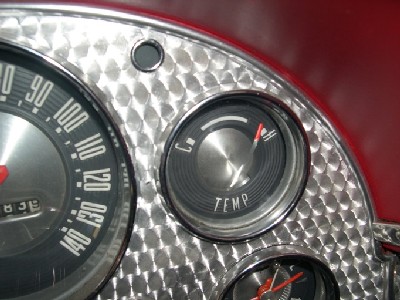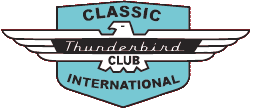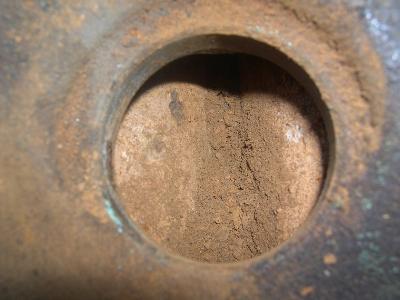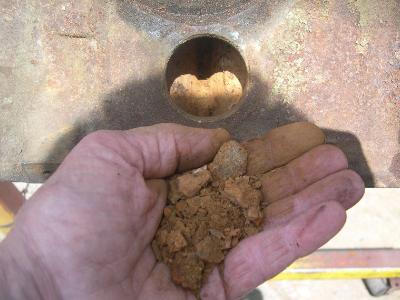 Gil’s Garage
Gil’s Garage
Gil Baumgartner
CTCI Authenticity Chairman
 When it comes to the1955/56/57 Thunderbirds, this subject more than likely, has been discussed and written about more than any other. Even when new, under certain driving conditions (parades & city driving) when coupled with excessive ambient temperature, the Thunderbirds were prone to run toward the hot side of normal. The primary reason for higher than normal operating temperature under these conditions was due to the design of the engine compartment. The small tight engine compartment did not allow for free air flow to carry out the hot air transferred from the radiator. Also, there is a basic design flaw in the water pump system. The T’Bird engines were the same engines used in thousands of Ford passenger cars and trucks, but the passenger cars and trucks did not have the same tendency to overheat.
When it comes to the1955/56/57 Thunderbirds, this subject more than likely, has been discussed and written about more than any other. Even when new, under certain driving conditions (parades & city driving) when coupled with excessive ambient temperature, the Thunderbirds were prone to run toward the hot side of normal. The primary reason for higher than normal operating temperature under these conditions was due to the design of the engine compartment. The small tight engine compartment did not allow for free air flow to carry out the hot air transferred from the radiator. Also, there is a basic design flaw in the water pump system. The T’Bird engines were the same engines used in thousands of Ford passenger cars and trucks, but the passenger cars and trucks did not have the same tendency to overheat.
The water pump for the Thunderbirds was the same as used on passenger cars and trucks. The timing cover for both the passenger car and Thunderbird were similar in design, both were built to accommodate the same water pump. The cavity for the water pump impeller was approximately 5/8″ deep. The water pump impeller was approximately ½” thick. This combination worked fine in the passenger cars and trucks. When the same engine was used in a Thunderbird it was necessary to install a 1&1/8″ spacer between the water pump and mounting cavity to accommodate belt alignments. When this spacer was installed the water pump impeller did not fill the extra one inch gap created by the water pump spacer. The results were a lesser volume of coolant being pumped through the engine. This lesser volume of coolant coupled with infrequent radiator flushes and coolant changes created an accumulation of solid rust around the rear cylinders of the block.
The above conditions cause overheating especially during city driving or parades. This problem can be overcome first by cleaning the block. The rust must be removed by breaking it loose and flushing it through the core plug holes. This can be done with the engine in the car, but best done with the engine removed. After the rust is removed, a high volume water pump with an extended impeller can be installed. The extended impeller was developed by CASCO and is available from them and maybe other dealers. In addition a thermostat with a larger opening can also be used. This combination has proven to be very effective without ill effect.
Other items that contribute to a cooler running engine are as follows.
- Head gaskets properly installed (square corner tab should be visible at the top front of the engine block) and are not leaking.
- Install a six blade fixed (nonflexible) fan. The edge of the fan should be out of the shroud approximately ¼”.
- Install a full radiator fan shroud (including lower section).
- Insure the timing is properly set throughout the full range of power. The 1955/56 must be set in two places. The initial advance of 3-6 degrees and the vacuum advance for acceleration and cruise. The 1957 model must be set in three places, initial, centrifugal and vacuum for acceleration. The exact specifications can be found in the shop manual available for each year from CTCI.
- When installing a new water pump the clearance between the water pump housing and back side of the impeller should be checked for proper clearance (0.030-0.040). This information can be found in the shop manuals.
- Insure the heat riser on the right hand exhaust manifold is working properly. It should operate freely by hand and open during acceleration and cruise. The counter weight goes down as it opens. Better yet replace the valve with dummy (flapper removed) or a spacer.
- Install an electric fan, especially if equipped with air conditioning and the car is used in parades or extended slow city driving. I prefer a pusher mounted in front of the radiator between the air condition condenser and radiator.
- Insure the radiator hoses are in good condition and not spongy especially the lower hose. The lower hose has an internal anti-collapse spring.
- Radiator should be clean and have at least four rows of cooling tubes and 14 fins per inch. Heavy-duty radiators are available.
- Coolant additives are available that claim to increase cooling capacity and reduce boiling.
- A smaller diameter water pump pulley is available from Thunderbird parts dealers which will increase the speed of the water pump which may be beneficial in parades and slow city driving.
All the parts mentioned in this article are available from major Thunderbird Parts dealers.
The most important items are a clean radiator, rust free block without build up around the internal water jackets and properly set timing throughout all power ranges.
The bottom line is after properly complying with all the suggestions and the engine still over heats it has rust build up as shown in the photos below or is a 312 with cylinder over bore of 0.080 or more.
Plugged Water passages
A major contributor to overheating conditions can be caused by neglecting the cooling system. It is recommended that the cooling system be drained and flushed every two years. Proper cooling system maintenance prevents rust and sludge buildup around the cylinder wall cooling jackets. The attached photos show what can happen when a cooling system is not properly maintained. Photo # 1 Shows rust build up in a Thunderbird 292/312 C.I. engine that had been neglected. Photo # 2 Shows some of the rust that was removed by hand. Photo # 3 Shows most of the rust removed.
Removal can be accomplished by: 1-Remove as much rust as possible by digging and probing with a coat hanger or similar object. 2-Pressure wash until all the rust is flushed from the block allowing coolant to flow freely around the external cylinder walls inside the engine block. 3-Replace the core plugs with brass plugs. When servicing the cooling system use a 50/50 mix of anti-freeze/coolant and water. Coolant rust inhibitors start to break down in a couple of years requiring the system to be drained and the coolant replaced. A clean cooling system promotes a cool running engine. Gil
Gil Baumgartner



